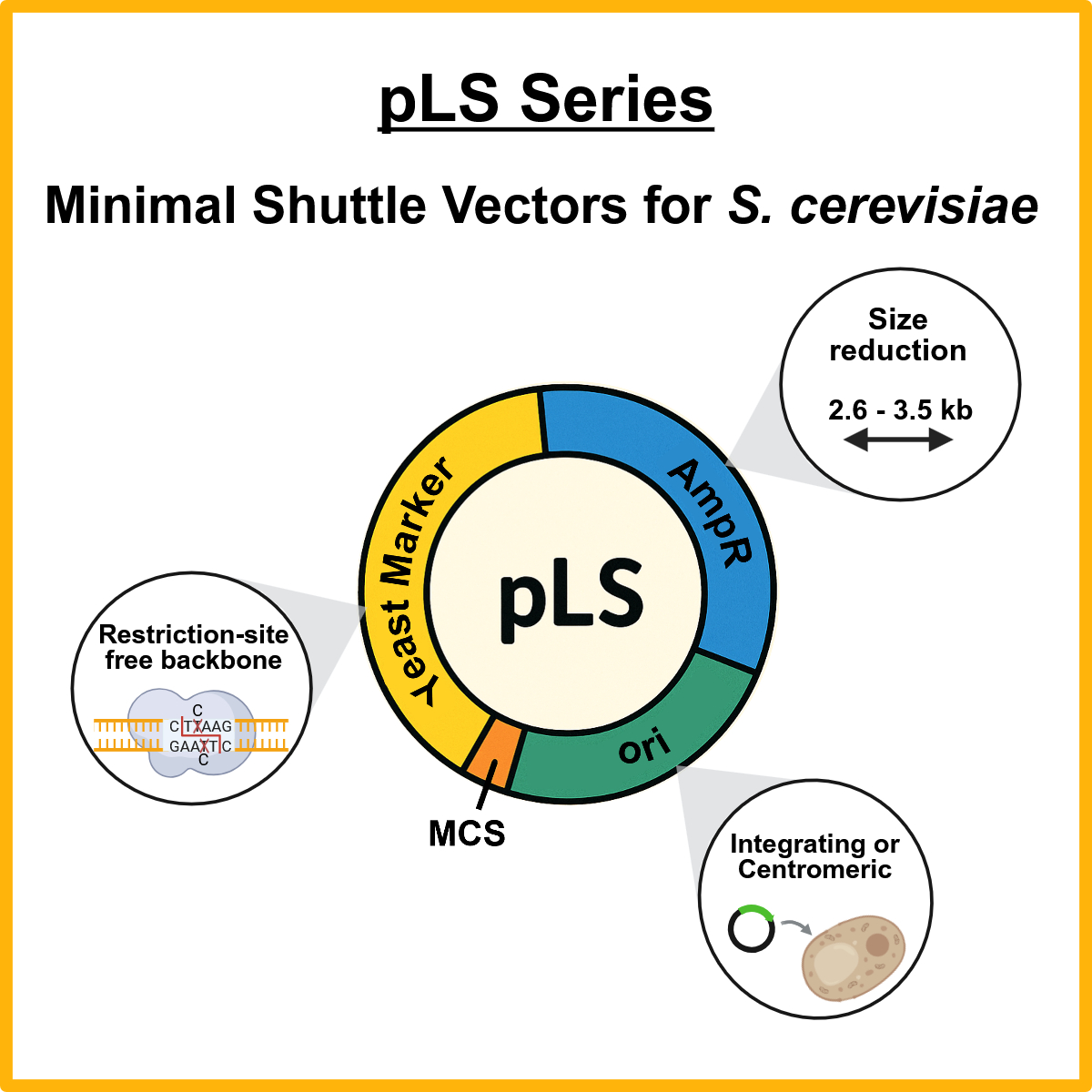pLS Series: Minimal Shuttle Vectors for Saccharomyces cerevisiae
(Kit #
1000000267
)
Depositing Lab: Sahand Jamal Rahi
The pLS collection consists of twelve minimal shuttle vectors for Escherichia coli and Saccharomyces cerevisiae. pLS vectors are smaller than the well-known pRS vectors, which are on average 63% larger. By removing non-essential elements and strategically eliminating restriction sites outside the polylinker region, these vectors provide valuable tools for synthetic biology in S. cerevisiae.
This kit will be sent as individual bacterial stabs at room temperature.
Original Publication
Minimal shuttle vectors for Saccharomyces cerevisiae. Scutteri L, Barth P, Rahi SJ. Synth Biol (Oxf). 2025 May 21;10(1):ysaf010. doi: 10.1093/synbio/ysaf010. PubMed 40612073 (Link opens in a new window) Article (Link opens in a new window)
Description
Yeast shuttle vectors generally range from 4–10 kb in size and harbor superfluous elements and restriction sites outside the multiple cloning site (MCS) that complicate experiments. Larger plasmids are more difficult to manipulate, and sophisticated genetic engineering tasks in synthetic biology are hampered by the lack of suitable vector backbones. To address these concerns, there has been a growing interest in developing size-reduced plasmids. This minimalistic philosophy aims to create compact, precisely-engineered vectors that only contain essential elements. By reducing plasmid size and eliminating unnecessary sequences, minimal plasmids have been shown to enhance cloning efficiency, gene transfer, and genetic manipulation.
We designed a collection of twelve minimal integrating or centromeric shuttle vectors for S. cerevisiae, a widely used model organism in synthetic biology. We constructed plasmids using de novo gene synthesis and consisting only of a yeast selection marker (HIS3, LEU2, TRP1, URA3, KanMX, or natMX6), a bacterial selection marker (Ampicillin resistance), an origin of replication (ORI), and the MCS flanked by M13 forward and reverse sequences. The MCS consists of ten unique restriction sites. Furthermore, we recoded the yeast selection markers and AmpR, and mutated terminators to enhance the availability of restriction sites for insert manipulation. We introduced, on average, 68 mutations per plasmid, removing most cut sites in the vector backbone while preserving the original amino acid sequences. Recoding the selectable markers recovered approximately 30 restriction sites recognized by widely used Type IIP and IIS restriction endonucleases in each plasmid.
We named our pLS series in accordance with the well-known pRS vectors, which are on average 63% larger: pLS400 and pLS410 (KanMX), pLS403 and pLS413 (HIS3), pLS404 and pLS414 (TRP1), pLS405 and pLS415 (LEU2), pLS406 and pLS416 (URA3), pLS408 and pLS418 (natMX6). To our knowledge, the pLS plasmids are the smallest shuttle vectors for yeast, ranging from approximately 2.6 kb to 3.5 kb in size. We anticipate that this resource will substantially simplify previously challenging genetic engineering tasks in S. cerevisiae.

Figure 1: pLS Minimal shuttle vectors for S. cerevisiae.
How to Cite this Kit
These plasmids were created by your colleagues. Please acknowledge the Principal Investigator, cite the article in which they were created, and include Addgene in the Materials and Methods of your future publications.
For your Materials and Methods section:
"The pLS Series was a gift from Sahand Jamal Rahi (Addgene kit #1000000267)."
For your Reference section:
Minimal shuttle vectors for Saccharomyces cerevisiae. Scutteri L, Barth P, Rahi SJ. Synth Biol (Oxf). 2025 May 21;10(1):ysaf010. doi: 10.1093/synbio/ysaf010. PubMed 40612073 (Link opens in a new window) Article (Link opens in a new window)


